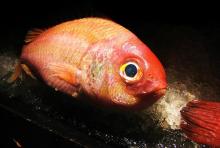Not only illegal and unethical but it can also lead to serious problems.
When it comes to seafood, it seems that most of the time, you're not getting what the menu says. The Boston Globe ran a series of DNA tests on local restaurant offerings and found that 24 of the 26 samples of red snapper, all of the 23 samples of white tuna, and a whole host of other samples (including fish labeled as flounder, Alaskan butterfish, baby cod, and New England cod) turned out to be cheaper species instead.
The Globe focused on white tuna and red snapper because these two species are both at the upper end of the price range. Since the fraud involves substituting a cheaper fish for a more expensive one, if you order cheap fish, you're probably getting what you ordered. However, it may not be exactly as described - according to the Globe, many fish described as "fresh caught" or "locally fished" are actually just the regular products of industrial factory fishing, caught in distant oceans, frozen, and shipped cross-country.
Times are tough for the restaurant business. Restaurants were never the best money-makers at the best of times, and the recession has caused a lot of people to substantially cut back on dining out, in order to make ends meet. But this has shaved a restaurant's already razor-thin margins even thinner.
It's easy to understand why a restaurant manager might substitute Vietnamese farmed catfish ($4/lb) for flounder ($23/fillet). But this practice is not only illegal and unethical, it can also lead to serious problems. The Globe found one restaurant substituting escolar for raw tuna - but escolar is "banned in Japan because it can make people sick." Later, the article mentions that escolar is also "nicknamed the "ex-lax" fish by some in the industry because of the digestion problems it can cause."
Yum!
Given what we know about the high ecological cost of getting wild fish to our plates, maybe this is just another sign that we as diners should stick to terrestrial meats when we go out for dinner. There are certainly plenty of problems with the terrestrial meat trade - from hens reared in battery cages to cattle on feed lots - but our nation's appetite for fish is rapidly stripping the oceans bare.
It's one thing to follow seafood guidelines like this set of suggestions from the Monterey Bay Aquarium. But the Seafood Watch Recommendations presume that you're getting the fish that you actually order! I can see several examples on the West Coast Guide where a cheaper red Avoid fish could be substituted for a more expensive green Best Choice fish.
